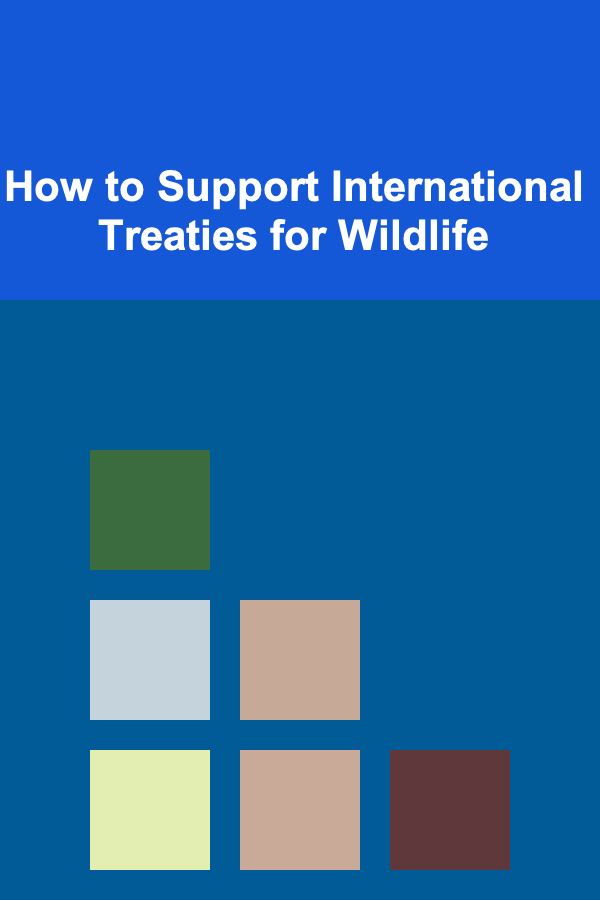
How to Support International Treaties for Wildlife
ebook include PDF & Audio bundle (Micro Guide)
$12.99$8.99
Limited Time Offer! Order within the next:

The world's wildlife faces unprecedented threats. Habitat loss, poaching, climate change, pollution, and invasive species are pushing countless species towards extinction. The survival of many iconic animals and essential ecosystems depends on concerted global action. International treaties are critical legal instruments that provide frameworks for governments to cooperate and address these challenges collectively. These agreements, painstakingly negotiated and often representing years of scientific research and political compromise, offer a crucial lifeline for endangered and threatened species worldwide. This document outlines diverse and impactful ways individuals, organizations, and governments can actively support and strengthen international treaties for wildlife conservation.
Understanding the Landscape of Wildlife Treaties
Before exploring specific actions, it's essential to understand the context of international wildlife treaties. These treaties vary significantly in scope, focus, and enforcement mechanisms. Some agreements target specific species or groups of species, while others address broader environmental issues that impact wildlife. Familiarizing yourself with the key treaties and their aims is the first step towards effective support.
Key International Treaties for Wildlife Conservation
- Convention on International Trade in Endangered Species of Wild Fauna and Flora (CITES): CITES regulates international trade in endangered and threatened species. It operates through a system of permits and certificates, classifying species into different appendices based on their vulnerability. Appendix I lists species threatened with extinction, and trade is permitted only in exceptional circumstances. Appendix II lists species that are not necessarily threatened with extinction but may become so unless trade is strictly regulated. Appendix III lists species that are protected in at least one country, which has asked other CITES Parties for assistance in controlling the trade. CITES is arguably the most successful and widely recognized wildlife treaty, but its effectiveness hinges on robust enforcement and monitoring by participating countries.
- Convention on Migratory Species (CMS): Also known as the Bonn Convention, CMS focuses on the conservation of migratory species throughout their range. It encourages range states to cooperate in protecting these species and their habitats. The convention works through a variety of agreements and memoranda of understanding (MoUs) tailored to specific species or groups of species, such as the African-Eurasian Migratory Waterbird Agreement (AEWA) and the Memorandum of Understanding on the Conservation of Migratory Sharks.
- Convention on Biological Diversity (CBD): The CBD is a broader treaty that aims to conserve biological diversity, promote the sustainable use of its components, and ensure the fair and equitable sharing of benefits arising from the use of genetic resources. While not exclusively focused on wildlife, the CBD addresses many factors that threaten wildlife populations, including habitat loss, invasive species, and climate change. It sets global biodiversity targets, such as the Kunming-Montreal Global Biodiversity Framework adopted in 2022, and encourages national biodiversity strategies and action plans.
- Ramsar Convention on Wetlands: This treaty focuses on the conservation and wise use of wetlands, which are crucial habitats for many wildlife species, particularly birds and fish. The Ramsar Convention requires signatory countries to designate wetlands of international importance as Ramsar sites and to manage them sustainably.
- World Heritage Convention: This convention protects cultural and natural heritage sites of outstanding universal value. Many World Heritage sites are important habitats for wildlife, and the convention provides a framework for their conservation.
- Regional Treaties: Numerous regional treaties also play a vital role in wildlife conservation. These include agreements focused on specific geographic areas or species groups, such as the African Convention on the Conservation of Nature and Natural Resources, the Agreement on the Conservation of Albatrosses and Petrels (ACAP), and various fisheries management agreements.
Understanding the nuances of these treaties -- their strengths, weaknesses, and areas for improvement -- is paramount for effective advocacy and support.
Actions Individuals Can Take
Supporting international wildlife treaties is not solely the responsibility of governments and organizations. Individuals can make a significant difference through informed action and advocacy.
Educate Yourself and Others
Knowledge is power. Learn about the threats facing wildlife, the role of international treaties, and the specific actions that can be taken to support conservation efforts. Share this knowledge with friends, family, and colleagues. Use social media, blogs, and community groups to raise awareness and promote informed discussions. Understanding the issues and sharing that understanding with others is the foundation for broader support.
- Read reports and publications from organizations like the UN Environment Programme (UNEP), the World Wildlife Fund (WWF), and the International Union for Conservation of Nature (IUCN). These organizations provide valuable data and analysis on wildlife conservation issues.
- Follow news and media coverage of wildlife conservation and international treaties. Stay informed about current events and emerging challenges.
- Share articles and information on social media. Use relevant hashtags to reach a wider audience.
- Organize presentations or workshops for community groups. Educate others about the importance of wildlife conservation and the role of international treaties.
Support Conservation Organizations
Numerous non-governmental organizations (NGOs) are working tirelessly to protect wildlife and support international treaties. These organizations often play a crucial role in monitoring treaty implementation, conducting research, advocating for stronger policies, and providing on-the-ground conservation efforts. Supporting these organizations through donations, volunteer work, or advocacy can have a significant impact.
- Donate to reputable conservation organizations. Ensure that the organization is transparent and accountable, and that its work aligns with your values.
- Volunteer your time and skills. Many organizations need volunteers to assist with research, outreach, and administrative tasks.
- Participate in citizen science projects. Contribute to scientific research by collecting data on wildlife populations or habitats.
- Advocate for conservation policies. Contact your elected officials and urge them to support legislation that protects wildlife and strengthens international treaties.
Make Sustainable Consumption Choices
Our consumption habits have a profound impact on wildlife populations and their habitats. By making conscious choices about the products we buy and the services we use, we can reduce our environmental footprint and support sustainable practices.
- Avoid purchasing products made from endangered or threatened species. Be aware of the illegal wildlife trade and avoid buying ivory, rhino horn, or other products derived from endangered animals.
- Choose sustainably sourced seafood. Look for certifications such as the Marine Stewardship Council (MSC) label.
- Reduce your meat consumption. Meat production is a major driver of deforestation and habitat loss.
- Support sustainable agriculture. Choose organic and locally grown produce.
- Reduce your use of plastics. Plastic pollution is a major threat to marine wildlife.
- Choose eco-friendly travel options. Consider the environmental impact of your travel plans and choose options that minimize your carbon footprint.
Advocate for Stronger Policies
Individual actions, while important, are not enough to address the scale of the challenges facing wildlife. Systemic changes are needed to strengthen international treaties and ensure their effective implementation. Individuals can play a crucial role in advocating for these changes.
- Contact your elected officials. Urge them to support legislation that protects wildlife and strengthens international treaties. Write letters, make phone calls, or attend town hall meetings.
- Participate in public consultations. Many governments hold public consultations on environmental policies. Use these opportunities to express your support for wildlife conservation and international treaties.
- Support political candidates who prioritize wildlife conservation. Vote for candidates who are committed to protecting the environment and supporting international agreements.
- Join advocacy groups. Work with other concerned citizens to lobby for stronger policies.
Actions Organizations Can Take
Organizations, both governmental and non-governmental, have a significant role to play in supporting international treaties for wildlife. Their influence and resources can be leveraged to promote treaty implementation, conduct research, and advocate for stronger policies.
Monitor and Report on Treaty Implementation
Effective treaty implementation requires diligent monitoring and reporting. Organizations can contribute by tracking the progress of signatory countries in meeting their obligations, identifying gaps in implementation, and reporting violations. This information can be used to hold governments accountable and to advocate for stronger enforcement measures.
- Conduct independent assessments of treaty implementation. Evaluate the effectiveness of national laws and policies in protecting wildlife and implementing treaty provisions.
- Monitor compliance with CITES regulations. Track the trade in endangered species and report any suspected violations.
- Document habitat loss and degradation. Monitor changes in land use and identify areas where wildlife habitats are being threatened.
- Report on the status of migratory species. Track population trends and identify threats to migratory routes.
- Publish reports and disseminate findings. Share your findings with governments, other organizations, and the public.
Conduct Scientific Research
Sound scientific research is essential for understanding the threats facing wildlife and for developing effective conservation strategies. Organizations can support international treaties by conducting research on endangered species, their habitats, and the impacts of human activities.
- Conduct population surveys of endangered species. Assess population sizes, distribution patterns, and trends.
- Study the ecology and behavior of endangered species. Understand their habitat requirements, feeding habits, and social interactions.
- Investigate the impacts of habitat loss and degradation on wildlife populations. Assess the effects of deforestation, urbanization, and other human activities.
- Assess the impacts of climate change on wildlife. Study how changing temperatures, precipitation patterns, and sea levels are affecting wildlife populations and habitats.
- Develop and test new conservation techniques. Explore innovative approaches to protecting wildlife and restoring habitats.
- Publish research findings in peer-reviewed journals. Share your findings with the scientific community and the public.
Provide Technical Assistance and Capacity Building
Many countries lack the resources and expertise to effectively implement international treaties. Organizations can provide technical assistance and capacity building to help these countries strengthen their conservation efforts.
- Provide training to government officials and conservation professionals. Offer workshops and courses on treaty implementation, wildlife management, and conservation techniques.
- Develop and disseminate educational materials. Create guides, manuals, and other resources to help people understand international treaties and conservation issues.
- Provide financial support for conservation projects. Fund projects that protect wildlife and restore habitats.
- Facilitate collaboration and information sharing between countries. Organize workshops and conferences to bring together experts from different countries to share best practices and lessons learned.
Engage with Local Communities
Effective wildlife conservation requires the involvement and support of local communities. Organizations can work with communities to promote sustainable livelihoods, reduce human-wildlife conflict, and empower local people to become stewards of their environment.
- Develop community-based conservation programs. Work with communities to design and implement conservation projects that meet their needs and priorities.
- Provide economic incentives for conservation. Offer payments for ecosystem services, such as protecting forests or managing wildlife populations.
- Promote sustainable tourism. Develop tourism opportunities that benefit local communities and protect wildlife habitats.
- Provide education and awareness programs for local communities. Inform people about the importance of wildlife conservation and the benefits of sustainable resource management.
- Address human-wildlife conflict. Develop strategies to minimize conflicts between humans and wildlife, such as providing compensation for livestock losses or implementing predator control measures.
Advocate for Stronger Treaty Provisions and Enforcement
International treaties are only as effective as their provisions and enforcement mechanisms. Organizations can advocate for stronger treaty provisions and for more effective enforcement measures.
- Advocate for stronger regulations on the trade in endangered species. Push for stricter penalties for wildlife trafficking and for improved monitoring of trade routes.
- Advocate for the protection of critical habitats. Support the designation of protected areas and the implementation of measures to prevent habitat loss and degradation.
- Advocate for the control of invasive species. Support measures to prevent the introduction and spread of invasive species, which can threaten native wildlife.
- Advocate for addressing climate change. Support policies that reduce greenhouse gas emissions and mitigate the impacts of climate change on wildlife.
- Advocate for increased funding for wildlife conservation. Urge governments to invest more resources in protecting wildlife and implementing international treaties.
Actions Governments Can Take
Governments bear the ultimate responsibility for implementing international treaties and protecting wildlife within their borders. Their actions are critical for ensuring the effectiveness of these agreements.
Ratify and Implement International Treaties
The first step towards supporting international treaties is to ratify them. Ratification signifies a country's commitment to upholding the treaty's provisions. However, ratification alone is not enough. Governments must also implement the treaties into their national laws and policies. This includes enacting legislation to protect endangered species, regulate trade in wildlife, and conserve critical habitats.
- Ratify all relevant international treaties. Commit to upholding the provisions of these agreements.
- Enact national laws and policies to implement treaty provisions. Translate the treaty's obligations into concrete actions.
- Establish clear lines of responsibility for treaty implementation. Designate government agencies to oversee specific aspects of treaty implementation.
- Allocate sufficient resources for treaty implementation. Ensure that government agencies have the funding and staff they need to carry out their responsibilities.
Enforce Treaty Provisions
Effective enforcement is essential for deterring violations of international treaties. Governments must establish strong enforcement mechanisms to investigate and prosecute wildlife crimes, such as poaching, illegal logging, and illegal trade in endangered species.
- Establish specialized law enforcement units to combat wildlife crime. Provide these units with the training and resources they need to effectively investigate and prosecute wildlife crimes.
- Implement strict penalties for wildlife crimes. Deter offenders by imposing significant fines and imprisonment sentences.
- Strengthen border controls to prevent illegal wildlife trade. Inspect shipments and monitor border crossings to detect and intercept illegal wildlife products.
- Cooperate with other countries to combat transnational wildlife crime. Share information and coordinate law enforcement efforts with other countries.
Conserve Critical Habitats
Protecting and restoring critical habitats is essential for the long-term survival of wildlife. Governments must establish and manage protected areas, such as national parks and wildlife reserves, and implement measures to prevent habitat loss and degradation outside of protected areas.
- Establish and manage a network of protected areas. Designate areas that are important for wildlife conservation and manage them to protect their biodiversity values.
- Implement land-use planning policies to prevent habitat loss and degradation. Control development and other activities that can harm wildlife habitats.
- Restore degraded habitats. Rehabilitate damaged ecosystems to provide suitable habitat for wildlife.
- Promote sustainable agriculture and forestry practices. Encourage practices that minimize the impacts on wildlife habitats.
Promote Sustainable Development
Sustainable development is essential for balancing economic growth with environmental protection. Governments must promote sustainable development policies that minimize the impacts on wildlife and ensure the long-term well-being of both people and the environment.
- Integrate biodiversity considerations into all development planning. Assess the potential impacts of development projects on wildlife and implement measures to mitigate those impacts.
- Promote sustainable tourism. Develop tourism opportunities that benefit local communities and protect wildlife habitats.
- Invest in renewable energy. Reduce reliance on fossil fuels, which contribute to climate change and habitat destruction.
- Promote sustainable consumption and production patterns. Encourage the use of resources more efficiently and reduce waste.
Support International Cooperation
International cooperation is essential for addressing the global challenges facing wildlife. Governments must actively participate in international negotiations and collaborate with other countries to implement international treaties.
- Participate actively in international negotiations on wildlife conservation. Advocate for strong treaty provisions and for effective implementation mechanisms.
- Share information and expertise with other countries. Collaborate on research, monitoring, and enforcement efforts.
- Provide financial and technical assistance to developing countries. Help developing countries strengthen their conservation efforts.
- Promote public awareness of international treaties and wildlife conservation issues. Educate the public about the importance of protecting wildlife and the role of international treaties.
Conclusion
Supporting international treaties for wildlife is a shared responsibility. Individuals, organizations, and governments all have a crucial role to play in ensuring the effectiveness of these agreements. By educating ourselves and others, supporting conservation organizations, making sustainable consumption choices, advocating for stronger policies, monitoring treaty implementation, conducting scientific research, providing technical assistance, engaging with local communities, enforcing treaty provisions, conserving critical habitats, promoting sustainable development, and supporting international cooperation, we can collectively contribute to the protection of the world's wildlife and the preservation of biodiversity for future generations.
The challenges are significant, but the potential rewards are immeasurable. By working together, we can create a future where wildlife thrives and ecosystems are healthy and resilient.

How to Create a DIY Candy Bar for Your Home Party
Read More
How to Set Up an Efficient Workflow for Crafting
Read More
How to Use Trellises for Vertical Plant Growth
Read More
How To Play the Trombone: Slide Positions and Tone
Read More
How to Introduce Financial Literacy Concepts to Kids
Read More
Understanding the Cosmic Microwave Background
Read MoreOther Products

How to Create a DIY Candy Bar for Your Home Party
Read More
How to Set Up an Efficient Workflow for Crafting
Read More
How to Use Trellises for Vertical Plant Growth
Read More
How To Play the Trombone: Slide Positions and Tone
Read More
How to Introduce Financial Literacy Concepts to Kids
Read More